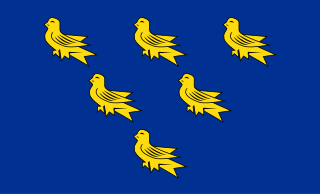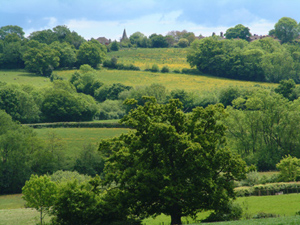
West Sussex is a county in South East England on the English Channel coast. The ceremonial county comprises the shire districts of Adur, Arun, Chichester, Horsham, and Mid Sussex, and the boroughs of Crawley and Worthing. Covering an area of 1,991 square kilometres, West Sussex borders Hampshire to the west, Surrey to the north, and East Sussex to the east. The county town and only city in West Sussex is Chichester, located in the south-west of the county. This was legally formalised with the establishment of West Sussex Council in 1888 but within the ceremonial Sussex. After the reorganisation of local government in 1974, the ceremonial function of the historic county of Sussex was divided into two separate counties, with the western half becoming West Sussex and the eastern half East Sussex. The existing East and West Sussex councils took control respectively, with Mid Sussex and parts of Crawley being transferred to West Sussex administration from East Sussex. In the 2011 census, West Sussex recorded a population of 806,900.

The South Downs National Park is England's newest national park, designated on 31 March 2010. The park, covering an area of 1,627 square kilometres (628 sq mi) in southern England, stretches for 140 kilometres (87 mi) from Winchester in the west to Eastbourne in the east through the counties of Hampshire, West Sussex and East Sussex. The national park covers the chalk hills of the South Downs and a substantial part of a separate physiographic region, the western Weald, with its heavily wooded sandstone and clay hills and vales. The South Downs Way spans the entire length of the park and is the only National Trail that lies wholly within a national park.

Sussex, from the Old English 'Sūþsēaxe', is a historic county in South East England.

The High Weald Area of Outstanding Natural Beauty is in south-east England. Covering an area of 1,450 square kilometres (560 sq mi), it takes up parts of the counties of East Sussex, Kent, West Sussex and Surrey in order of respective contribution. It is the fourth largest Area of Outstanding Natural Beauty (AONB) in England and Wales. It has an attractive landscape with a mosaic of small farms and woodlands, historic parks, sunken lanes and ridge-top villages.

Bethersden is a village and civil parish in the borough of Ashford in Kent, England, 5 miles (8 km) west of the town of Ashford. Located on the main road, A28, between Tenterden and Ashford.

Broadbridge Heath is a village and civil parish in the Horsham district of West Sussex, England. It is about two miles (3 km) west from the historic centre of Horsham. The population of Broadbridge Heath has increased considerably in the first two decades of the twenty-first century because of large scale housing development.
Purbeck Marble is a fossiliferous limestone found in the Isle of Purbeck, a peninsula in south-east Dorset, England. It is a variety of Purbeck stone that has been quarried since at least Roman times as a decorative building stone.

The Purbeck Group is an Upper Jurassic to Lower Cretaceous lithostratigraphic group in south-east England. The name is derived from the district known as the Isle of Purbeck in Dorset where the strata are exposed in the cliffs west of Swanage.

Northchapel is a village and civil parish in Chichester District in West Sussex, England. It stands on the A283 road just south of the Surrey border, around 9 km north of Petworth.

The Greensand Ridge, also known as the Wealden Greensand is an extensive, prominent, often wooded, mixed greensand/sandstone escarpment in south-east England. Forming part of the Weald, a former dense forest in Sussex, Surrey and Kent, it runs to and from the East Sussex coast, wrapping around the High Weald and Low Weald. It reaches its highest elevation, 294 metres (965 ft), at Leith Hill in Surrey—the second highest point in south-east England, while another hill in its range, Blackdown, is the highest point in Sussex at 280 metres (919 ft). The eastern end of the ridge forms the northern boundary of Romney Marsh.

Tillington is a village, ecclesiastical parish and civil parish in the District of Chichester in West Sussex, England, 1 mile (1.6 km) west of Petworth on the A272. The civil parish (CP) includes the hamlets of Upperton, River, and River Common. The land area of the CP is 1,416 hectares ; approximately 500 people lived in 227 households at the 2001 census.
Purbeck stone refers to building stone taken from a series of limestone beds found in the Upper Jurassic to Lower Cretaceous Purbeck Group, found on the Isle of Purbeck, Dorset in southern England. The best known variety of this stone is Purbeck Marble. The stone has been quarried since at least Roman times up to the present day.

Sussex is a historic county and cultural region in the south of England corresponding roughly in area to the ancient Kingdom of Sussex. It is bounded on the north by Surrey, north-east by Kent, south by the English Channel, and west by Hampshire, and is divided for local government into West Sussex and East Sussex and the city of Brighton and Hove. The city of Brighton & Hove was created a unitary authority in 1997, and was granted City status in 2000. Until then Chichester had been Sussex's only city. By convention, Chichester is Sussex's capital city and Lewes is Sussex's county town.

Horsham Stone is a type of calcareous, flaggy sandstone containing millions of minute sand grains and occurring naturally in the Weald Clay of south-east England. It is also high in mica and quartz. The rock extends in an arc-like formation for several kilometres around the town of Horsham from which it takes its name, and lies just below the Weald Clay surface in bands 4 to 5 inches thick. Horsham Stone is significant for its ripple-marked appearance, formed by the action of the sea similar to the ripples on the sandbanks and beaches of Sussex.

All Saints Church is an Anglican church in the hamlet of Highbrook in Mid Sussex, one of seven local government districts in the English county of West Sussex. The tiny settlement, in the parish of West Hoathly, was distant from the parish church in that village; two wealthy sisters accordingly funded the construction of a new church to serve the local population. Richard H. Carpenter and Benjamin Ingelow's stone building, with a prominent spire, opened in 1884 and was allocated its own parish. The "handsome" church, designed in the 14th/15th-century style of the Gothic Revival, has been listed at Grade II by English Heritage for its architectural and historical importance.

St Mary Magdalene's Church is an Anglican church in the village of Bolney in Mid Sussex, one of seven local government districts in the English county of West Sussex. The parish church, which is dedicated to Jesus' companion Mary Magdalene, serves a large rural parish centred on a village straddling the ancient London–Brighton road and apparently dates from about 1100, and an older origin has been suggested. Many structural additions have been made over the centuries—including a tower built solely using the labour of villagers—and at the entrance to the churchyard is a "magnificent" 20th-century lychgate made of local materials including Sussex Marble. The church is protected as a Grade I Listed building.

St Margaret's Church is an Anglican church in the village of West Hoathly in Mid Sussex, one of seven local government districts in the English county of West Sussex. By the late 11th century, a simple single-room stone building existed on the high, open ridge upon which the village developed. A series of medieval expansions doubled its size by the 15th century, and the present building has changed little since then—despite a Victorian restoration overseen by architect R. H. Carpenter. A major addition was the heavily buttressed Perpendicular Gothic west tower, topped with a tall broach spire and containing a peal of ancient bells. The large, steeply terraced churchyard also serves as a public cemetery and has far-reaching views across the Weald. The original dedication to Saint Margaret of Antioch fell out of use for many centuries until a researcher rediscovered it. The church serves a large rural parish which was reduced in size in 1882 when two residents of the hamlet of Highbrook paid for an additional church to be built there. English Heritage has listed it at Grade I for its architectural and historical importance.

Sussex Day is the county day for the historic county of Sussex in southern England and is celebrated on 16 June each year to celebrate the rich heritage and culture of Sussex.
The geology of West Sussex in southeast England comprises a succession of sedimentary rocks of Cretaceous age overlain in the south by sediments of Palaeogene age. The sequence of strata from both periods consists of a variety of sandstones, mudstones, siltstones and limestones. These sediments were deposited within the Hampshire and Weald basins. Erosion subsequent to large scale but gentle folding associated with the Alpine Orogeny has resulted in the present outcrop pattern across the county, dominated by the north facing chalk scarp of the South Downs. The bedrock is overlain by a suite of Quaternary deposits of varied origin. Parts of both the bedrock and these superficial deposits have been worked for a variety of minerals for use in construction, industry and agriculture.

A ledger stone or ledgerstone is an inscribed stone slab usually laid into the floor of a church to commemorate or mark the place of the burial of an important deceased person. The term "ledger" derives from the Middle English words lygger, ligger or leger, themselves derived from the root of the Old English verb liċġan, meaning to lie (down). Ledger stones may also be found as slabs forming the tops of tomb chest monuments.

















